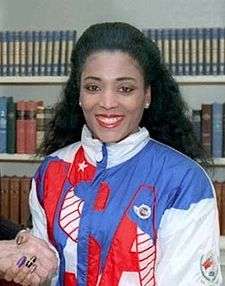Sports in the United States
| This article is part of a series on the |
| Culture of the United States of America |
|---|
| Society |
| Arts and literature |
| Other |
| Symbols |
|
United States portal |
Sports in the United States are an important part of American culture. Based on revenue, the four major professional sports leagues in the United States are Major League Baseball (MLB), the National Basketball Association (NBA), the National Football League (NFL), and the National Hockey League (NHL). The market for professional sports in the United States is roughly $69 billion, roughly 50% larger than that of all of Europe, the Middle East, and Africa combined.[1] Major League Soccer (MLS) is sometimes included in a "top five" of leagues of the country. All four enjoy wide-ranging domestic media coverage and are considered the preeminent leagues in their respective sports in the world, although American football does not have a substantial following in other nations. Three of those leagues have teams that represent Canadian cities, and all four are the most financially lucrative sports leagues of their sport. American football ranks top as the favorite sport to watch in the United States followed by basketball, baseball, and soccer.[2] Tennis, golf, wrestling, auto racing, arena football, field lacrosse, box lacrosse and volleyball are also popular sports in the country.
Professional teams in all major sports in the United States operate as franchises within a league, meaning that a team may move to a different city if the team's owners believe there would be a financial benefit, but franchise moves are usually subject to some form of league-level approval. All major sports leagues use a similar type of regular-season schedule with a playoff tournament after the regular season ends. In addition to the major league–level organizations, several sports also have professional minor leagues, active in smaller cities across the country. As in Canada and Australia, sports leagues in the United States do not practice promotion and relegation, unlike many sports leagues in Europe.
Sports are particularly associated with education in the United States, with most high schools and universities having organized sports, and this is a unique sporting footprint for the U.S. College sports competitions play an important role in the American sporting culture, and college basketball and college football are as popular as professional sports in some parts of the country. The major sanctioning body for college sports is the National Collegiate Athletic Association (NCAA).
Unlike most other nations, the United States government does not provide funding for sports nor for the United States Olympic Committee.
History
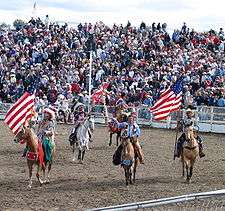
The history of sports in the United States shows that most sports evolved out of European practices. However, basketball, volleyball, skateboarding, and snowboarding are American inventions, some of which have become popular in other countries and worldwide. Lacrosse and surfing arose from Native American and Native Hawaiian activities that predate Western contact.[3]
In Chesapeake society (that is, colonial Virginia and Maryland), sports occupied a great deal of attention at every social level, starting at the top. In England, hunting was severely restricted to landowners. In America, game was more than plentiful. Everyone—including servants and slaves—could and did hunt, so there was no social distinction to be had. In 1691, Sir Francis Nicholson, the governor of Virginia, organized competitions for the “better sort of Virginians onely who are Batchelors,” and he offered prizes “to be shot for, wrastled, played at backswords, & Run for by Horse and foott.”[4]
Olympics

The United States Olympic Committee (USOC) is the National Olympic Committee for the United States. U.S. athletes have won a total of 2,522 medals (1,022 of them being gold) at the Summer Olympic Games and another 305 at the Winter Olympic Games. Most medals have been won in athletics (track and field) (801, 32%) and swimming (553, 22%). American swimmer Michael Phelps is the most decorated Olympic athlete of all time, with 28 Olympic medals, 23 of them gold.
The United States has sent athletes to every celebration of the modern Olympic Games except the 1980 Summer Olympics hosted by the Soviet Union in Moscow, which it boycotted because of the Soviet invasion of Afghanistan.

The United States has won gold at every games in which it has competed, more gold and overall medals than any other country in the Summer Games and also has the second-most gold and overall medals in the Winter Games, trailing only Norway. From the mid-20th century to the late 1980s, the United States mainly competed with the Soviet Union at the Summer Games and with the Soviet Union, Norway, and East Germany at the Winter Games. However, after the dissolution of the Soviet Union, it now primarily contends with China and Great Britain at the Summer Games for both the overall medal count and the gold medal count and with Norway and Canada at the Winter Games for the overall medal count.
The United States hosted both Summer and Winter Games in 1932, and has hosted more Games than any other country – eight times, four times each for the Summer and Winter Games:
- the 1904 Summer Olympics in St. Louis, 1932 Summer Olympics and 1984 Summer Olympics in Los Angeles; and the 1996 Summer Olympics in Atlanta;
- the 1932 Winter Olympics and 1980 Winter Olympics in Lake Placid, New York; the 1960 Winter Olympics in Squaw Valley, California; and the 2002 Winter Olympics in Salt Lake City, Utah.
Los Angeles will host the Summer Olympics for a third time in 2028, marking the ninth time the U.S. hosts the Olympic Games.
Individual sports
Motorsports

Motor sports are widely popular in the United States but Americans generally show little interest in the major international competitions, such as the Formula One Grand Prix series and MotoGP, preferring home-grown racing series. However, some Americans have achieved great success in these international series, such as Mario Andretti and Kenny Roberts.
Americans, like the rest of the world, initially began using public streets to host automobile races, but these venues were often unsafe to the public as they offered relatively little crowd control. Promoters and drivers in the United States discovered that horse racing tracks could provide better conditions for drivers and spectators than public streets. The result has been a long-standing popularity of oval track racing, which is not used in the rest of the world, while road racing has generally waned. However, an extensive though illegal street racing culture still persists.[5]
IndyCar Series

Historically, open wheel racing was the most popular form of U.S. motorsport nationwide. However, an infamously acrimonious split (often referred to by many as "The Split") in 1994 between the primary series, CART (later known as Champ Car), and the owner of the Indianapolis Motor Speedway (the site of the Indy 500), Tony George, led to the formation of the Indy Racing League, now known as INDYCAR, which launched the rival IndyCar Series in 1996. From that point on, the popularity of open wheel racing in the U.S. declined dramatically.[6] The feud was settled in 2008 with an agreement to merge the two series under the IndyCar banner, but enormous damage had already been done to the sport.[7] Post-merger, IndyCar continues to remain with slight viewership gains per year. However, as a result, the only post-Split IndyCar race that still enjoys widespread popularity among the general public is the Indianapolis 500.
NASCAR
.jpg)
The CART-IRL Split coincided with an enormous expansion of stock car racing, governed by NASCAR, from its past as a mostly regional circuit mainly followed in the Southern United States to a truly national sport. NASCAR's audience peaked in the mid 1990's, and has declined quite a bit ever since the implementation of the Chase for the Cup in 2004, though it continues to have around 2–4 million viewers per race. Among NASCAR's popular former drivers are Jeff Gordon, Dale Earnhardt, Matt Kenseth, Tony Stewart, Dale Earnhardt Jr., and Richard Petty. Among NASCAR's popular active drivers are Jimmie Johnson, Kurt Busch, Kyle Busch, Chase Elliott, Ryan Blaney, and Kyle Larson. NASCAR's most popular race is the Daytona 500, the opening race of the season, held each year at Daytona Beach, Florida in February.
Other motorsports
Among the better known sports car races in the United States are the 24 Hours of Daytona, 12 Hours of Sebring, and Petit Le Mans, which have featured in the World Sportscar Championship, IMSA GT Championship, Intercontinental Le Mans Cup, FIA World Endurance Championship, American Le Mans Series, Rolex Sports Car Series and currently the United SportsCar Championship.
Another one of the most popular forms of motorsports in the United States is the indigenous sport of drag racing. The largest drag racing organization is the National Hot Rod Association.
Several other motorsports enjoy varying degrees of popularity in the United States: short track motor racing, motocross, monster truck competitions (including the popular Monster Jam circuit), demolition derby, figure 8 racing, mud bogging and tractor pulling.
Golf
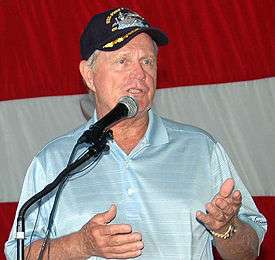
Golf is played in the United States by about 25 million people. The sport's national governing body, the United States Golf Association (USGA), is jointly responsible with The R&A for setting and administering the rules of golf. The USGA conducts four national championships open to professionals: the U.S. Open, U.S. Women's Open, U.S. Senior Open, and the U.S. Senior Women's Open, with the last of these holding its first edition in 2018. The PGA of America organizes the PGA Championship, Senior PGA Championship and Women's PGA Championship. Three legs of the Grand Slam of Golf are based in the United States: the PGA Championship, U.S. Open and The Masters. (The Open Championship, known in the U.S. as the British Open, is played in the United Kingdom.)
The PGA Tour is the main professional golf tour in the United States, and the LPGA Tour is the main women's professional tour. Also of note is PGA Tour Champions, where players 50 and older compete. Golf is aired on several television networks, such as Golf Channel, NBC, ESPN, CBS and Fox.
Notable American male golfers include Walter Hagen (11 majors), Ben Hogan, Jack Nicklaus (record 18 major wins), Arnold Palmer, and Tiger Woods (14 major wins). Notable female golfers include Patty Berg (record 15 major wins), Mickey Wright (13 majors), Louise Suggs and Babe Zaharias.
Tennis
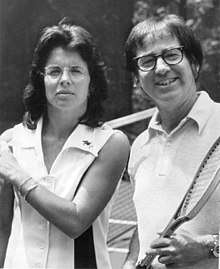
Tennis is played in the United States in all five categories (Men's and Ladies' Singles; Men's, Ladies' and Mixed Doubles); however, the most popular are the singles. The pinnacle of the sport in the country is the US Open played in late August at the USTA Billie Jean King National Tennis Center in New York. The Indian Wells Masters, Miami Masters and Cincinnati Masters are part of the ATP World Tour Masters 1000 and the former WTA Tier I (currently Premier Mandatory and Premier 5).
The United States has had considerable success in tennis for many years, with players such as Don Budge, Billie Jean King, Chris Evert, Jimmy Connors (8 major singles titles), John McEnroe (7 major singles titles), Andre Agassi (8 major singles titles) and Pete Sampras (14 major singles titles) dominating their sport in the past. More recently, the Williams sisters, Venus Williams (7 major singles titles) and Serena Williams (23 major singles titles), have been a dominant force in the women's game, and the twin brothers Bob and Mike Bryan have claimed almost all significant career records for men's doubles teams.
Track and field
USA Track & Field is the governing body for track and field in the United States. It organizes the annual USA Outdoor Track and Field Championships and USA Indoor Track and Field Championships. The IAAF Diamond League currently features one round in the United States, the Prefontaine Classic; the series formerly included the Adidas Grand Prix as well. Three of the World Marathon Majors are held in the United States: the Boston Marathon, Chicago Marathon and New York City Marathon. The Freihofer's Run for Women is also an IAAF Road Race Label Event.
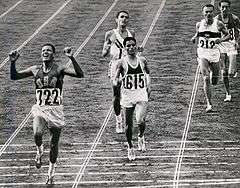
Americans have frequently set world standards in various disciplines of track and field for both male and female athletes. Tyson Gay and Michael Johnson hold various sprint records for male athletes, while Florence Griffith Joyner set various world sprint records for female athletes. Mary Slaney set many world records for middle-distance disciplines.
A turning point occurred in US track in the running boom of the 1970s.[11] After a series of American successes in various distances from marathoners Frank Shorter and Bill Rodgers as well as middle-distance runners Dave Wottle and Steve Prefontaine, running as an American pastime began to take shape. High school track in the United States became a unique foundation for creating the United States middle-distance running talent pool, and from 1972 to 1981 an average of 13 high school boys in the United States would run under 4:10 in the mile per year.[11] During this time, several national high school records in the United States were set and remained largely unbroken until the 2000s. The number of high school boys running the mile under 4:10 per year dropped abruptly from 1982,[11] and female participation in many distance events was forbidden by athletic authorities until the 1980s.[12] However a renaissance in high school track developed when Jack Daniels, a former Olympian, published a training manual called "Daniels' Running Formula", which became the most widely used distance training protocol among American coaches[11] along with Arthur Lydiard's high-mileage regimen. Carl Lewis is credited with "normalizing" the practice of having a lengthy track career as opposed to retiring once reaching the age when it is less realistic of gaining a personal best result. The United States is home to school-sponsored track and field, a tradition in which most schools from middle school through college feature a track and field team. Due to the amount of American athletes who satisfy Olympic norm standards, the US holds national trials to select the best of its top-tier athletes for Olympic competition.
Combat sports
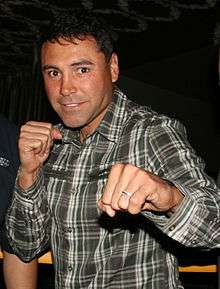
Boxing in the United States became the center of professional boxing in the early 20th century.[13] The National Boxing Association was founded in 1921 and began to sanction title fights. In the 1960s and 1970s, Muhammad Ali became an iconic figure, transformed the role and image of the African American athlete in America by his embrace of racial pride, and transcended the sport by refusing to serve in the Vietnam War. In the 1980s and 1990s, major boxers such as Mike Tyson and Riddick Bowe were marked by crime and self-destruction.
Mixed martial arts in the United States developed in the 1990s, and has achieved popularity in the early 21st century. Many companies promote MMA cards, with the U.S.-based UFC the most dominant.[14]
Traditional wrestling is performed at the scholastic level; high school wrestling is one of the most popular participatory sports for young men in the United States, and college wrestling has a small following.
Professional wrestling, which evolved into a mostly scripted (kayfabe) form of sports entertainment over the course of the 20th century, enjoys widespread popularity as a spectator sport. Interest in pro wrestling peaked during the Monday Night Wars of the 1980s and 1990s. This was due to the competition between the World Wrestling Federation (WWF) and WCW, which were the two biggest professional wrestling organizations in the country during the last two decades of the 20th century. It is also stated that, between the two companies, an estimated 16 million viewers tuned in every week. Following the conclusion of the Wars and WCW's subsumption into WWF to become the modern WWE, professional wrestling's audience has diminished; however, it still pulls in some of cable television's highest weekly ratings. WWE remains the dominant professional wrestling company in the U.S.; it does not hold a monopoly, as numerous smaller federations have existed, two current examples including Impact Wrestling (formerly known as TNA) and Ring of Honor (ROH).
Judo in the United States is not very popular and is eclipsed by more popular martial arts like karate and taekwondo.
Swimming and water sports

Swimming is a major competitive sport at high school and college level, but receives little mainstream media attention outside of the Olympics.
Surfing in the United States and watersports are popular in the U.S. in coastal areas. California and Hawaii are the most popular locations for surfing. The Association of Surfing Professionals was founded in 1983.
Other popular individual sports

- Skateboarding – Skateboarding culture was born in the U.S., which holds many of the top tournaments and produces the majority of professional skateboarders.
- Hunting and fishing are popular in the U.S., especially in rural areas. Other popular outdoors activities in the country include hiking, mountain climbing, paintball and kayaking. In winter, many Americans head to mountainous areas for skiing and snowboarding.
- Road bicycle racing has increased in popularity, fueled by the success of cyclists Greg LeMond and the eight consecutive Tours de France won by American contestants (although all eight were discarded in the wake of doping revelations against the two winners, Lance Armstrong and Floyd Landis). Mountain biking is also widely practiced, especially in the Rocky Mountains.
- Rodeo – The Professional Rodeo Cowboys Association is the main professional rodeo organization in the world. Bull riding, a subset of the rodeo, enjoys popularity as a standalone sport, especially the pro competition, Professional Bull Riders.
- Horse racing – The Breeders' Cup and the Triple Crown are the two most prominent competitions.
- Bowling – Bowling is the most popular participation "game" sport in the U.S. with more than 43 million people going bowling at least once a year.[15]
- Figure skating is a sport in which individuals, duos, or groups perform on figure skates on ice. It was the first winter sport included in the Olympics, in 1908.
Popular team sports
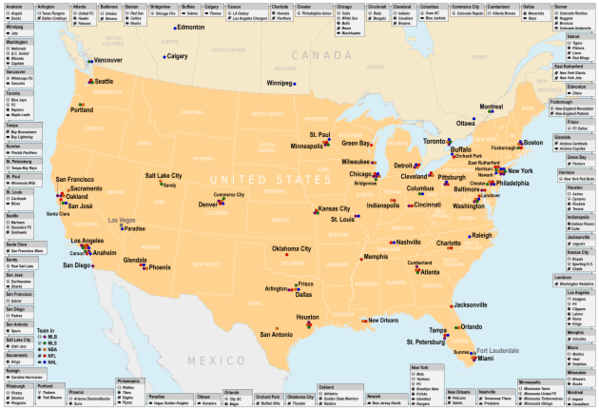
Overview
The most popular team sports in the United States are American football, baseball/softball, basketball, ice hockey, and soccer (association football). All five of these team sports are popular with fans, are widely watched on television, have a fully professional league, are played by millions of Americans, enjoy varsity status at many Division I colleges, and are played in high schools throughout the country.
| Sport | Favorite sport[16] | TV viewing record (since 2005)1 | Major professional league | Participants (millions)[17] | NCAA DI Teams (Men + Women) | States (HS)2 |
|---|---|---|---|---|---|---|
| American football | 37% | 111.9m | NFL | 8.9 m | 249 (249M + 0W) | 50 |
| Basketball | 11% | 24.4m | NBA | 30.3 m | 589 (298M + 291W) | 50 |
| Baseball/Softball | 9% | 40.0m | MLB | 29.3 m | 698 (351M + 349W) | 50 |
| Soccer | 7% | 27.3m | MLS | 13.6 m | 531 (205M + 332W) | 50 |
| Ice hockey | 4% | 27.6m | NHL | 3.1 m | 95 (59M + 36W) | 15 |
- TV viewing record measures the game with the most TV viewers in the U.S. since 2005 for each sport: 2016 Super Bowl,[18] 2016 NBA Finals Game 7,[19] 2016 World Series Game 7,[20] 2014 FIFA World Cup Final,[21] and 2010 Winter Olympics Gold medal ice hockey game.[22]
- The column titled "States (HS)" represents the number of states that sponsor the sport at the high school level.[23]
American football
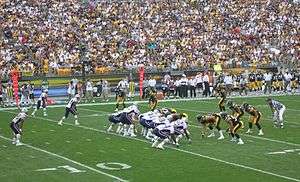
Football, known as American football outside the United States, has the most participants of any sport at both high school and college levels, the vast majority of its participants being male.[24][25]
The NFL is the preeminent professional football league in the United States. The NFL has 32 franchises divided into two conferences. After a 16-game regular season, each conference sends six teams to the NFL Playoffs, which eventually culminate in the league's championship game, the Super Bowl.
Nationwide, the NFL obtains the highest television ratings among major sports. Watching NFL games on television on Sunday afternoons has become a common routine for many Americans during the football season. Super Bowl Sunday is the biggest annual sporting event held in the United States. The Super Bowl itself is always among the highest-rated programs of all-time in the Nielsen ratings.
Millions watch college football throughout the fall months, and some communities, particularly in rural areas, place great emphasis on their local high school football teams. The popularity of college and high school football in areas such as the Southern United States (Southeastern Conference) and the Great Plains (Big 12 Conference and Big Ten Conference) stems largely from the fact that these areas historically generally did not possess markets large enough for a professional team.[26] Nonetheless, college football has a rich history in the United States, predating the NFL by decades, and fans and alumni are generally very passionate about their teams.
.jpg)
During football season in the fall, fans have the opportunity to watch high school games on Fridays and Saturdays, college football on Saturdays, and NFL games on Sundays, the usual playing day of the professional teams. However, some colleges play games on Tuesday and Wednesday nights, while the NFL offers weekly games on Monday (since 1970) and Thursday (since 2006). As recently as 2013, one could find a nationally televised professional or college game on television any night between Labor Day and Thanksgiving weekend.

Notable former NFL players include Roger Staubach, Dick Butkus, Joe Greene, Bart Starr, Johnny Unitas, Walter Payton, Joe Montana, Steve Young, Jerry Rice, Brett Favre, Emmitt Smith, Ray Lewis, and Peyton Manning. Notable current NFL players include Drew Brees, Tom Brady, Cam Newton, J. J. Watt, Russell Wilson, Marshawn Lynch, and Aaron Rodgers.
Indoor American football or arena football, a form of football played in indoor arenas, has several professional and semi-professional leagues. The Arena Football League was active from 1987 to 2008 and folded in 2009, but several teams from the AFL and its former minor league, af2, relaunched the league in 2010. Most other extant indoor leagues date to the mid-2000s and are regional in nature.
Women's American football is seldom seen. A few amateur and semi-professional leagues exist, of varying degrees of stability and competition. Football is unique among scholastic sports in the U.S. in that no women's division exists for the sport; women who wish to play football in high school or college must compete directly with men.
Baseball
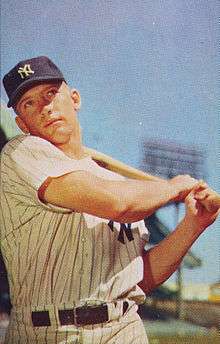
Baseball and a variant, softball, are popular participatory sports in the U.S. The highest level of baseball in the U.S. is Major League Baseball. The World Series of Major League Baseball is the culmination of the sport's postseason each October. It is played between the winner of each of the two leagues, the American League and the National League, and the winner is determined through a best-of-seven playoff.

The New York Yankees are noted for having won more titles than any other US major professional sports franchise. The Yankees' chief rivals, the Boston Red Sox, also enjoy a huge following in Boston and throughout New England. The fierce National League rivalry between the former Brooklyn Dodgers and New York Giants was transferred to the West Coast when the teams became the Los Angeles Dodgers and the San Francisco Giants, and California has always been among the US states which have supplied the most players in the major leagues. Chicago sports fans also avidly follow the Chicago Cubs and the Chicago White Sox despite the comparative lack of success for the teams, with Chicago Cub fans being known throughout the country for their passionate loyalty to the team despite their not having won a championship from 1908 to 2016. Historically, the leagues were much more competitive, and cities such as Boston, Philadelphia and St. Louis had rival teams in both leagues up until the 1950s.
Notable American baseball players in history include Babe Ruth (714 career home runs), Ty Cobb (career leader in batting average and batting titles), Cy Young, Honus Wagner, Ted Williams (.344 career batting average), Lou Gehrig, Joe DiMaggio, Mickey Mantle (16-time all star), Stan Musial, Willie Mays, Yogi Berra (18-time All-Star), Hank Aaron (career home run leader from 1974 to 2007), Nolan Ryan (career strikeouts leader), Roger Clemens (7 Cy Young awards), Derek Jeter and Jackie Robinson, who was instrumental in dissolving the color line and allowing African-Americans into the major leagues.
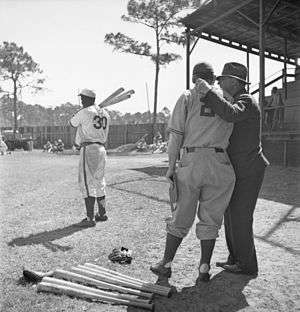
An extensive minor league baseball system covers most mid-sized cities in the United States. Minor league baseball teams are organized in a six-tier hierarchy, in which the highest teams (AAA) are in major cities that do not have a major league team but often have a major team in another sport, and each level occupies progressively smaller cities. The lowest levels of professional baseball serve primarily as development systems for the sport's most inexperienced prospects, with the absolute bottom, the rookie leagues, occupying the major league squads' spring training complexes.
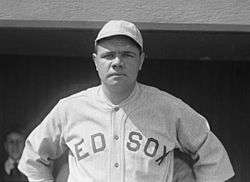
Some limited independent professional baseball exists, the most prominent being the Atlantic League, which occupies mostly suburban locales that are not eligible for high level minor league teams of their own because they are too close to other major or minor league teams.
Outside the minor leagues are collegiate summer baseball leagues, which occupy towns even smaller than those at the lower end of minor league baseball and typically cannot support professional sports. Summer baseball is an amateur exercise and uses players that choose not to play for payment in order to remain eligible to play college baseball for their respective universities in the spring. At the absolute lowest end of the organized baseball system is senior amateur baseball (also known as Town Team Baseball), which typically plays its games only on weekends and uses rosters composed of local residents.
Basketball
Of those Americans citing their favorite sport, basketball is ranked second (counting amateur levels) behind American football. However, in regards to money the NBA is ranked third in popularity.[28] More Americans play basketball than any other team sport, according to the National Sporting Goods Association, with over 26 million Americans playing basketball. Basketball was invented in 1891 by Canadian physical education teacher James Naismith in Springfield, Massachusetts.
The National Basketball Association (NBA) is the world's premier men's professional basketball league and one of the major professional sports leagues of North America. It contains 30 teams (29 teams in the U.S. and 1 in Canada) that play an 82-game season from October to June. After the regular season, eight teams from each conference compete in the playoffs for the Larry O'Brien Championship Trophy.
Since the 1992 Summer Olympics, NBA players have represented the United States in international competition and won numerous important tournaments. The Dream Team was the unofficial nickname of the United States men's basketball team that won the gold medal at the 1992 Olympics.
Basketball at both the college and high school levels is popular throughout the country. Every March, a 68-team, six-round, single-elimination tournament (commonly called March Madness) determines the national champions of NCAA Division I men's college basketball.
Most U.S. states also crown state champions among their high schools. Many high school basketball teams have intense local followings, especially in the Midwest and Upper South. Indiana has 10 of the 12 largest high school gyms in the United States,[29] and is famous for its basketball passion, known as Hoosier Hysteria.
.jpg)
Notable NBA players in history include Wilt Chamberlain (4 time MVP), Bill Russell (5 time MVP), Bob Pettit (11 time all NBA team), Bob Cousy (12 time all NBA team), Jerry West (12 time all NBA team), Julius Erving (won MVP awards in both the ABA and NBA), Kareem Abdul-Jabbar (6 time MVP), Magic Johnson (3 time MVP), Larry Bird (3 time MVP), Michael Jordan (6 time finals MVP), John Stockton (#1 in career assists and steals), Karl Malone (14 time all NBA team), Kobe Bryant (NBA's third all-time leading scorer), Tim Duncan (15-time NBA all-star), Shaquille O'Neal (3 time finals MVP) and Jason Kidd (#2 in career assists and steals).
Notable players in the NBA today include LeBron James (4 MVP awards), Stephen Curry (2 time MVP), Dwyane Wade (10 time all-star), and Kevin Durant (MVP, 4 NBA scoring titles). Ever since the 1990s, an increasing number of players born outside the United States have signed with NBA teams, sparking league interest in different parts of the world.

Professional basketball is most followed in cities where there are no other sports teams in the four major professional leagues, such as in the case of the Oklahoma City Thunder,[31] the Sacramento Kings, the San Antonio Spurs, the Memphis Grizzlies, or the Portland Trail Blazers. New York City has also had a long historical connection with college and professional basketball, and many basketball legends initially developed their reputations playing in the many playgrounds throughout the city. Madison Square Garden, the home arena of the New York Knicks, is often referred to as the "Mecca of basketball."
Minor league basketball, both official and unofficial, has an extensive presence, given the sport's relative lack of expense to operate a professional team. The NBA has an official minor league, known since 2017 as the NBA G League under a naming rights agreement with Gatorade. The most prominent independent league is BIG3, a three-on-three league featuring former NBA stars that launched in 2017. Several other pro basketball leagues exist but are notorious for their instability and low budget operations.
The WNBA is the premier women's basketball league in the United States as well as the most stable and sustained women's professional sports league in the nation. Several of the 12 teams are owned by NBA teams. The women's national team has won seven Olympic gold medals and nine FIBA World Cups.
Ice hockey
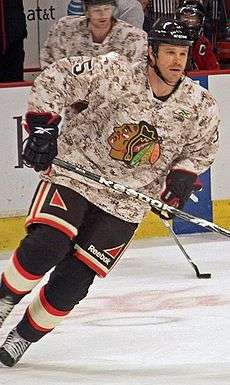
Ice hockey, usually referred to in the U.S. simply as "hockey", is another popular sport in the United States. In the U.S. the game is most popular in regions of the country with a cold winter climate, namely the northeast and the upper Midwest. However, since the 1990s, hockey has become increasingly popular in the Sun Belt due in large part to the expansion of the National Hockey League to the southern U.S., coupled with the mass relocation of many residents from northern cities with strong hockey support to these Sun Belt locations.
The NHL is the major professional hockey league in North America, with 24 U.S.-based teams and 7 Canadian-based teams competing for the Stanley Cup. While NHL stars are still not as readily familiar to the general American public as are stars of the NFL, MLB, and the NBA, average attendance for NHL games in the U.S. has surpassed average NBA attendance in recent seasons, buoyed in part by the NHL Winter Classic being played in large outdoor stadiums.
Minor league professional hockey leagues in the U.S. include the American Hockey League and the ECHL. Additionally, nine U.S.-based teams compete in the three member leagues of the Canadian Hockey League, a "junior" league for players aged sixteen to twenty. College hockey has a regional following in the northeastern and upper midwestern United States. It is increasingly being used to develop players for the NHL and other professional leagues (the U.S. has junior leagues, the United States Hockey League and North American Hockey League, but they are more restricted to protect junior players' college eligibility). The Frozen Four is college hockey's national championship. The U.S. now has more youth hockey players than all other countries, excluding Canada, combined.[32] USA Hockey is the official governing body for amateur hockey in the United States. The United States Hockey Hall of Fame is located in Eveleth, Minnesota.
Internationally, the United States is counted among the Big Six, the group of nations that have historically dominated international ice hockey competition. (The others include Canada, Finland, Sweden, the Czech Republic, and Russia.) One of the nation's greatest ever sporting moments was the "Miracle on Ice", which came during the 1980 Winter Olympics when the U.S. hockey team beat the Soviet Union 4–3 in the first game of the medal round before going on to beat Finland to claim the gold medal.
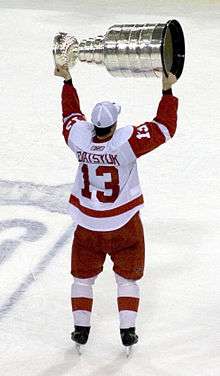
Historically, the vast majority of NHL players had come from Canada, with a small number of Americans. As late as 1969–70, Canadian players made up 95 percent of the league.[32] During the 1970s and 1980s, European players entered the league, and many players from the former Soviet bloc flocked to the NHL beginning in the 1990s. Today, the majority of NHL players are Canadian, more than 20% are Americans, and virtually all of the remainder are European-trained. (For a more complete discussion, see Origin of NHL players.)
Notable NHL players in history include Wayne Gretzky (leading all-time point scorer and 9 time MVP), Mario Lemieux (3 time MVP), Guy Lafleur (2 time MVP), Gordie Howe (6 time MVP), Nicklas Lidström (7 times NHL's top defenseman), Bobby Hull (3 time MVP and 7 time leading goal scorer, Eddie Shore (4 time MVP), Howie Morenz (3 time MVP), Maurice "Rocket" Richard (5 time leading goal scorer), Jean Beliveau (2 time MVP) and Bobby Orr (8 times NHL's best defenseman). Famous NHL players today include Sidney Crosby and Alexander Ovechkin.
The National Women's Hockey League, founded in 2015, is the first women's ice hockey league in the country to pay its players and features five teams in the northeast and upper midwest. Two of the five teams (the Buffalo Beauts and Metropolitan Riveters) are either owned or operated by their metro area's NHL franchise (the Buffalo Sabres and New Jersey Devils, respectively). At the international level, the United States women's national ice hockey team is one of the two predominant international women's teams in the world, alongside its longtime rival Team Canada.
Soccer
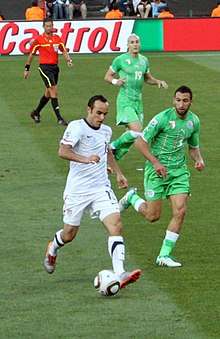
Soccer has been increasing in popularity in the United States in recent years. Soccer is played by over 13 million people in the U.S., making it the third-most played sport in the U.S., more widely played than ice hockey and American football. Most NCAA Division I colleges field both a men's and women's varsity soccer team, and those that field only one team almost invariably field a women's team.
The United States men's national team and women's national team, as well as a number of national youth teams, represent the United States in international soccer competitions and are governed by the United States Soccer Federation (U.S. Soccer). The U.S. women's team holds the record for most Women's World Cup championships, and is the only team that has never finished worse than third place in a World Cup. The U.S. women beat Japan 5–2 in the 2015 FIFA Women's World Cup final to claim their third Women's World Cup title, and first since 1999.
.jpg)
Major League Soccer is the premier soccer league in the United States. MLS has 23 clubs (20 from the U.S. and 3 from Canada). The 34-game schedule runs from mid-March to late October, with the playoffs and championship in November. Soccer-specific stadiums continue to be built for MLS teams around the country, both because American football stadiums are considered to have excessive capacity, and because teams profit from operating their stadiums. Other professional men's soccer leagues in the U.S. include the current second division, the United Soccer League, and the North American Soccer League, which had been the second-level league until being demoted in 2018 due to instability. The USL now has a formal relationship with MLS, and a number of its teams are either owned by or affiliated with MLS sides.
.jpg)
Younger generations of Americans have strong fan appreciation for the sport, due to factors such as the U.S. hosting of the 1994 FIFA World Cup and the formation of Major League Soccer, as well as increased U.S. television coverage of soccer competitions. Many immigrants living in the United States continue to follow soccer as their favorite team sport. United States will host the 2026 FIFA World Cup sharing with Canada and Mexico.
Women's professional soccer in the United States has not seen sustained success. Following the demise of two professional leagues in the early 21st century, the Women's United Soccer Association (1999–2001) and Women's Professional Soccer (2009–2011), U.S. Soccer established a new National Women's Soccer League in 2013. The NWSL has now survived longer than either of its two professional predecessors, and five of its current nine teams are owned by professional men's clubs (four in MLS and one in the USL). However, at the lower levels of the salary scale, the NWSL is effectively semi-professional.
Many notable international soccer players played in the U.S. in the original North American Soccer League, usually at the end of their playing careers—including Pelé, Eusébio, George Best, Franz Beckenbauer, and Johan Cruyff—or in MLS—including Roberto Donadoni, Lothar Matthäus, David Beckham, Thierry Henry, Kaká, and David Villa. The best American soccer players enter the U.S. Soccer Hall of Fame.
Other team sports
Overview
The following table shows additional sports that are played by over 500,000 people in the United States.
| Sport | Participants (millions) | NCAA teams (Men + Women)[33] | Semi-Pro League(s) | Attendance Record1 | TV Viewership Record2 | Olympic Sport |
|---|---|---|---|---|---|---|
| Volleyball | 10.7 m[17] | 1,173 (109M + 1,064W) | PVL | 17,209 | 794,000 | Yes |
| Ultimate | 4.9 m[34] | 0 | AUDL | 1,175 | 86,000 | No |
| Rugby | 1.4 m[35] | 19 (2M + 17W) | MLR | 61,500 | 9,000,000 | Yes |
| Lacrosse | 0.7 m[36] | 782 (339M + 443W) | NLL; MLL | 48,970 | 476,000 | No |
- Attendance record measures highest single-game attendances. Attendance records are: Volleyball: 2016 NCAA championship;[37] Ultimate: 2013 Major League Ultimate;[38] Rugby: 2014 New Zealand vs. Ireland in Chicago;[39] and Lacrosse: 2008 NCAA men's lacrosse championship finals.[40]
- TV viewership records are: Volleyball: 2010 NCAA women's championship on ESPN2; Rugby: 2018 Rugby World Cup Sevens on NBC ; Lacrosse: 2016 NCAA championship on ESPN2; Ultimate: 2015 College championship men's final.
Lacrosse

Lacrosse is a team sport that is believed to have originated with the Iroquois and the Lenape. Lacrosse is most popular in the East Coast area. The National Lacrosse League and Major League Lacrosse are the national box and outdoor lacrosse leagues, respectively, with both leagues operating on a semi-professional level.[41]
Volleyball
Volleyball is also a notable sport in the United States, especially at the college and university levels. Unlike most Olympic sports which are sponsored widely at the collegiate level for both sexes, the support for college volleyball is dramatically skewed in favor of the women's game. In the 2011–12 school year, over 300 schools in NCAA Division I alone (the highest of three NCAA tiers) sponsored women's volleyball at the varsity level,[42] while fewer than 100 schools in all three NCAA divisions combined sponsored varsity men's volleyball, with only 23 of them in Division I.[43] This is partially due to Title IX; female-oriented sports such as volleyball help balance a college's athletic opportunities for women with those for men.

The men's national team has won three gold medals at the Olympic Games, one FIVB World Championship, two FIVB Volleyball World Cup, and one FIVB World League. Meanwhile, the women's national team has won the one FIVB World Championship and six editions of the FIVB World Grand Prix.
Beach volleyball has increasingly become popular in the United States, in part due to media exposure during the Olympic Games.
Rugby union
Rugby union is played professionally, recreationally and in colleges, though it is not governed by the NCAA (see college rugby). An estimated 1.2 million people in the United States play rugby.[44] The U.S. national team has competed at the Rugby World Cup. In rugby sevens, the men's national team is one of 15 "core teams" that participate in every event of the annual World Rugby Sevens Series, and the women's national team is one of 11 core teams in the Women's Sevens Series. The professional domestic club competition PRO Rugby began play in April 2016,[44] but lasted only one season; a second attempt at a professional league, Major League Rugby, launched in 2018.
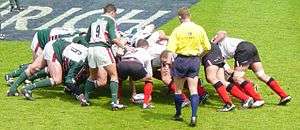
Rugby union participation in the U.S. has grown significantly in recent years, growing by 350% between 2004 and 2011.[45] A 2010 survey by the National Sporting Goods Manufacturers Association ranked rugby union as the fastest-growing sport in the U.S.[46] The sports profile in the U.S. has received a tremendous boost from the IOC's announcement in 2009 that rugby union would return to the Olympics in 2016. Since the Olympic announcement, rugby union events such as the Collegiate Rugby Championship, the USA Sevens, and the Rugby World Cup have been broadcast on network TV. The USA Sevens, held every year in February or March as part of the World Rugby Sevens Series and adding a parallel women's event in the World Rugby Women's Sevens Series in 2017, regularly draws more than 60,000 fans to Sam Boyd Stadium in Las Vegas.
Rugby football formed the basis of modern American football; the two sports were nearly identical in the late 19th century but diverged into distinct, incompatible codes by the start of the 20th century.
Cricket
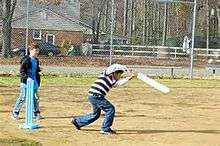
In 2006 it was estimated that 30,000 people in the United States play or watch cricket annually.[47] By 2017, this figure had risen to 200,000 people playing cricket in 6,000 teams.[48] Cricket in the United States is not as popular as baseball and is not as popular among as large a fraction of the population as it is within either the Commonwealth nations or the other ICC full member (or Test cricket) nations.[49] There are at least two historical reasons for the relative obscurity of cricket within the United States. One reason was the 19th-century-rise of the summer time bat and ball sport now called baseball, which seems to have displaced cricket as a popular pastime.[49] Another reason was that in 1909 when the ICC was originally organized as the Imperial Cricket Conference it was open only to Commonwealth nations and thereby excluded the US from participating in the sport at the highest level.[50]
Nevertheless, in 1965 the US was admitted to the renamed ICC as an associate member and the sport grew in popularity in the second half of the 20th century. An oft mentioned reason for the growing popularity of cricket is the growing population of immigrants to the US who come from cricket playing nations.[47][49]
With the launching of the United States Youth Cricket Association in 2010, a more focused effort to bring the game to American schools was begun, with the intention of broadening cricket's fan base beyond expatriates and their children.[51]
ESPN has been stepping up its coverage of cricket in recent years, buying the cricket website Cricinfo in 2007, and broadcasting the final of the 2014 ICC World Twenty20 competition, the 2014 Indian Premier League, English County Championship games, and international Test cricket.[52]
Ultimate and disc sports

Ultimate is a team sport played with a flying disc. The object of the game is to score points by passing the disc to members of your own team until you have completed a pass to a team member in the opposing teams end zone. Over 5.1 million people play some form of organized ultimate in the US.[53]
Alternative sports, using the flying disc, began in the mid-sixties, when numbers of young people looked for alternative recreational activities, including throwing a Frisbee.[54] What started with a few players experimenting with a Frisbee later would become known as playing disc freestyle.[55] Organized disc sports in the 1970s began with a few tournaments, and professionals using Frisbee show tours to perform at universities, fairs and sporting events. Disc sports such as disc freestyle, disc dog (with a human handler throwing discs for a dog to catch), double disc court, disc guts, disc ultimate, and disc golf became this sport's first events.[56][57]
Disc guts was invented in the 1950s and developed at the International Frisbee Tournament. Ultimate, the most widely played disc sport, began in the late 1960s. In the 1970s it developed as an organized sport with the creation of the Ultimate Players Association. Double disc court was invented and introduced in the early 1970s. In 1974, disc freestyle competition was created.[58] In 1976, the game of disc golf was standardized by the Professional Disc Golf Association. Beginning in 1974, the International Frisbee Association became the regulatory organization for all of these sports.[59]
Disc sports includes both ultimate and disc golf. Ultimate has added the American Ultimate Disc League, which began play in 2012. However, the league is still competing at a lower level than club teams established across the U.S.[60][61]
In 2015, the International Olympic Committee granted full recognition to the World Flying Disc Federation for flying disc sports including Ultimate.[62][63]
Other sports
The development of snowboarding was inspired by skateboarding, sledding, surfing and skiing. It was developed in the United States in the 1960s, became a Winter Olympic Sport at Nagano in 1998 and first featured in the Winter Paralympics at Sochi in 2014.
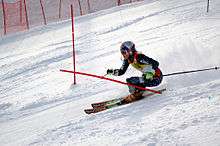
Australian rules football in the United States was first played in the country in 1996.[64] The United States Australian Football League is the governing body for the sport in the U.S, with various clubs and leagues around the country. The National Championships are held annually. The United States men's national Australian rules football team and the women's national team both regularly play international matches, and play in the Australian Football International Cup, an international tournament. The sport also benefits from an active fan based organization, the Australian Football Association of North America.
Bandy is only played in Minnesota. The national team regularly plays in Division A of the Bandy World Championships. In terms of licensed athletes, it is the second biggest winter sport in the world.[65]
Cricket in the United States is not a popular sport, but has a niche market with limited inroads, mainly in immigrant communities.[66] The United States of America Cricket Association governs cricket in the United States. Historically, cricket used to be the most popular sport in America during the 18th and early 19th centuries, but declined as baseball overtook cricket. The first intercollegiate tournament in America was the first annual Canada vs. U.S. cricket match, played since 1844, when it was attended by 10,000 spectators in New York., and the annual match is the oldest international sporting event in the modern world.[67] The United States national cricket team plays in World Cricket League Division IV, the ICC Americas Championship and qualified for ICC Intercontinental Cup.
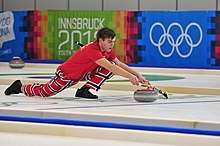
Curling is popular in northern states, possibly because of climate, proximity to Canada, or Scandinavian heritage. The national popularity of curling is growing after significant media coverage of the sport in the 2006 and 2010 Winter Olympics.
Gaelic football and hurling are governed by North American GAA and New York GAA. They do not have a high profile, but are developing sports, with New York fielding a representative team in the All-Ireland Senior Football Championship.
Field hockey is played in the United States predominantly by women. It is played widely at numerous NCAA colleges, where it is used as a sport to offset Title IX regulations assuring equal opportunities for men and women in sports (it thus offsets male-dominated sports such as college football).
Handball, a common sport in European countries, is seldom seen in the United States. The sport is mostly played in the country on the amateur level. Handball is played in the Summer Olympics, but is not sanctioned by the NCAA; all college and university teams play as club teams. The sport's governing body is USA Team Handball.
Inline hockey was invented by Americans as a way to play the sport in all climates. The PIHA is the league with the largest number of professional teams in the nation. Street hockey is a non-standard version of inline hockey played by amateurs in informal games.
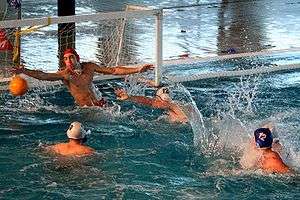
Rugby league in the United States is played by the USA Rugby League (USARL) is a 14 team semi-professional rugby league football competition based on the East Coast of the United States. The league was founded in 2011 by clubs that had broken with the established American National Rugby League (AMNRL), plus expansion franchises. The USARL began its inaugural season in 2011. In November 2014, the USARL were granted Affiliate membership of the RLIF and RLEF and are now the official governing body for the sport in the USA. The United States national rugby league team played in their first World Cup in 2013 losing to Australia in the quarter finals 62–0.[68][69] The United States, along with Canada, will host the 2025 Rugby League World Cup.[70]
Water polo does not have a professional competition in the U.S., so the highest level of competitive play is at the college level and in the Olympics. The NCAA sanctions water polo as a varsity sport for both men and women, but sport is not popular in the U.S. beyond the west coast, and no team outside of California has ever reached the finals of the NCAA Division I men's water polo championship.
Other team recreational activities
_in_Orange_Countyy%2C_Los_Angeles_July_9-11%2C_2009_-_(28653423212).jpg)
Angleball is a sport developed as a way to maintain physical fitness.[71] Angleball is used by colleges, schools, and camps. Angleball gameplay is simple. Two large balls are placed atop standards at opposite sides of a field. Teams pass a smaller ball back and forth, attempting to knock the other team's ball off its perch with the smaller ball.
Badminton has also become a popular backyard sport in the United States.
Capture the flag is played recreationally by adults and children.
Dodgeball is played traditionally by children in school, though adult leagues in urban areas have formed within the past 10 years. A caricatured version was portrayed in the 2004 film comedy Dodgeball: A True Underdog Story.
Kickball is also played recreationally by adults and children, especially at the elementary school level. Its rules are largely identical to baseball, except that no bat is used and instead a large rubber ball is rolled along the ground for the "batter" to kick.
Roller derby is a contact sport played on roller skates that has had brief surges of popularity throughout the 20th and 21st centuries. Roller Derby was portrayed in the 2009 film Whip It. Since September 2009, there were 350 women's, men's, and junior leagues in the U.S.A.[72]
Organization of American sports
Professional sports
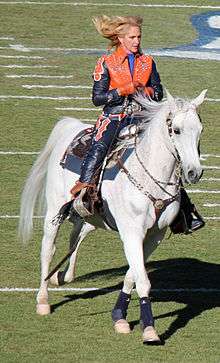
For the most part, unlike sports in Europe and other parts of the world, there is no system of promotion and relegation in American professional sports. Major sports leagues operate as associations of franchises. The same 30–32 teams play in the league each year unless they move to another city or the league chooses to expand with new franchises.
All American sports leagues use the same type of schedule. After the regular season, the 10–16 teams with the best records enter a playoff tournament leading to a championship series or game. American sports, except for soccer, have no equivalent to the cup competitions that run concurrently with leagues in European sports. Even in the case of soccer, the cup competition, the Lamar Hunt U.S. Open Cup, draws considerably less attention than the regular season. Also, the only top-level U.S. professional teams that play teams from other organizations in meaningful games are those in MLS. Since the 2012 season, all U.S.-based MLS teams have automatically qualified for the U.S. Open Cup, in which they compete against teams from lower-level U.S. leagues. In addition, three or four U.S.-based MLS teams (depending on the results of the U.S. Open Cup) qualify to play clubs from countries outside the U.S. and Canada in the CONCACAF Champions League.[n 1] NBA teams have played European teams in preseason exhibitions on a semi-regular basis, and recent MLS All-Star Games have pitted top players from the league against major European soccer teams, such as members of the Premier League.
International competition is not as important in American sports as it is in the sporting culture of most other countries, although Olympic ice hockey and basketball tournaments do generate attention. The first international baseball tournament with top-level players, the World Baseball Classic, also generated some positive reviews after its inaugural tournament in 2006.
The major professional sports leagues operate drafts once a year, in which each league's teams selected eligible prospects. Eligibility differs from league to league. Baseball and ice hockey operate minor league systems for players who have finished education but are not ready or good enough for the major leagues. The NBA also has a development league for players who are not ready to play at the top level.
College sports
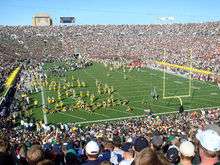
The extent in the United States to which sports are associated with secondary and tertiary education is rare among nations. Millions of students participate in athletics programs operated by high schools and colleges. Student-athletes often receive scholarships to colleges in recognition of their athletic potential. Currently, the largest governing body of collegiate sports is the National Collegiate Athletic Association (NCAA).
Especially in football and basketball, college sports are followed in numbers equaling those of professional sports. College football games can draw over 100,000 spectators. For upper-tier institutions, sports are a significant source of revenue; for less prominent teams, maintaining a high-level team is a major expense. To ensure some semblance of competitive balance, the NCAA divides its institutions into three divisions (four in football), sorted by the number of athletic scholarships each school is willing to offer.
The most practiced college sports, measured by NCAA reporting on varsity team participation,[73] are: (1) football (64,000), (2) baseball/softball (47,000), (3) track and field (46,000),[74] (4) soccer (43,000), (5) basketball (32,000), (6) cross-country running (25,000), and (7) swimming/diving (20,000). The most popular sport among female athletes is soccer, followed closely by track and field.[25]
Community college athletics are governed separately by the National Junior College Athletic Association (NJCAA).
High school sports

Most public high schools are members of their respective state athletic association, and those associations are members of the National Federation of State High School Associations (NFHS). Some states have separate associations for public and non-public high schools.
As of 2018, the NFHS reported 29 consecutive years of increasing high school sports participation, driven largely by growth in girls participation.[75] The high school sports with the highest number of participants for 2017 are:
- Team sports[76]
- Football[hs 1] – 1,059,399
- Basketball – 980,673
- Baseball/Softball[hs 2] – 868,819
- Soccer – 838,573
- Volleyball – 501,988
- Individual sports[76]
- Track & field (outdoor) – 1,094,613
- Cross country – 492,310
- Tennis – 345,690
- Swimming & diving – 309,161
- Wrestling – 259,391
- Notes
Popular high school sports in various regions of the U.S. include the Texas High School football championships, the Indiana basketball championships, and ice hockey in Minnesota. The Minnesota State High School Hockey Tournament is the largest high school sporting event in the country, with average attendance to the top tier, or "AA", games over 18,000.
Amateur sports
The Amateur Athletic Union claims to have over 670,000 participants and over 100,000 volunteers.. The AAU has been around since 1888, and has been influential in amateur sports for more than 125 years.
In the 1970s, the AAU received growing criticism. Many claimed that its regulatory framework was outdated. Women were banned from participating in certain competitions and some runners were locked out. There were also problems with sporting goods that did not meet the standards of the AAU. During this time, the Amateur Sports Act of 1978 organized the United States Olympic Committee and saw the re-establishment of state-supported independent associations for the Olympic sports, referred to as national governing bodies. As a result, the AAU lost its influence and importance in international sports, and focused on the support and promotion of predominantly youthful athletes, as well as on the organization of national sports events.
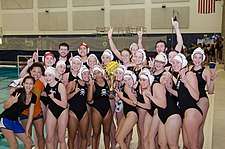
_Amy_Winczura_(5694030475).jpg)
Government regulation
No American government agency is charged with overseeing sports. However, the President's Council on Physical Fitness and Sports advises the President through the Secretary of Health and Human Services about physical activity, fitness, and sports, and recommends programs to promote regular physical activity for the health of all Americans. The U.S. Congress has chartered the United States Olympic Committee to govern American participation in the Olympic Movement and promote Olympic sports. Congress has also involved itself in several aspects of sports, notably gender equity in college athletics, illegal drugs in pro sports, sports broadcasting and the application of antitrust law to sports leagues.
Individual states may also have athletic commissions, which primarily govern individual sports such as boxing, kickboxing and mixed martial arts. Notable state athletic commissions are the Nevada Athletic Commission, California State Athletic Commission, New York State Athletic Commission and New Jersey State Athletic Control Board. Although these commissions only have jurisdiction over their own states, the Full Faith and Credit Clause of the U.S. Constitution is often interpreted as forcing all other states to recognize any state athletic commission's rulings regarding an athlete's fitness for participating in a sport.
Sports media in the United States
Sports have been a major part of American broadcasting since the early days of radio.[77] Today, television networks and radio networks pay millions (sometimes billions) of dollars for the rights to broadcast sporting events. Contracts between leagues and broadcasters stipulate how often games must be interrupted for commercials. Because of all of the advertisements, broadcasting contracts are very lucrative and account for the biggest chunk of major professional teams' revenues. Broadcasters also covet the television contracts for the major sports leagues (especially in the case of the NFL) in order to amplify their ability to promote their programming to the audience, especially young and middle-aged adult males.[78]
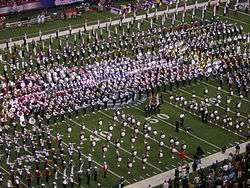
The advent of cable and satellite television has greatly expanded sports offerings on American TV.[79] ESPN, the first all-sports cable network in the U.S., went on the air in 1979. It has been followed by several sister networks and competitors. Some sports television networks are national, such as CBS Sports Network, Fox Sports 1 and NBC Sports Network, whereas others are regional, such as Comcast SportsNet, Fox Sports Networks and Time Warner Cable SportsChannel.[80] General entertainment channels like FX, TBS, TNT, and USA Network also air sports events. Some sports leagues have their own sports networks, such as NFL Network, MLB Network, NBA TV, NHL Network, Big Ten Network, Pac-12 Network and SEC Network. Some sports teams run their own television networks as well.[81]
Sports are also widely broadcast at the local level, ranging from college and professional sports down to (on some smaller stations) recreational and youth leagues.[79] Internet radio has allowed these broadcasts to reach a worldwide audience.
| Sports rights | Sport | National TV contract | Total Revenues (Per Year) | Ref |
|---|---|---|---|---|
| National Football League (NFL) | American football | CBS, Fox, NBC, ESPN, DirecTV, Verizon | $56bn ($7.0bn) | |
| National Basketball Association (NBA) | Basketball | ABC, ESPN, TNT | $24bn ($2.7bn) | [82] |
| Major League Baseball (MLB) | Baseball | Fox, ESPN, TBS | $12bn ($1.6bn) | |
| March Madness | Basketball | CBS, Turner | $8.8bn ($1.1bn) | |
| NASCAR | Auto racing | NBC, Fox | $8.2bn ($820m) | |
| Olympic Games | Multi-sport | NBC | $7.8bn ($705m) | |
| College Football Playoff | Football | ESPN | $5.6bn ($470m) | |
| Pac-12 Conference (Pac-12) | College sports | Fox, ESPN | $3.0bn ($250m) | |
| Big Ten Conference (Big 10) | College sports | Fox, ESPN | $2.6bn ($440m) | [83] |
| Big 12 Conference (Big 12) | College sports | Fox, ESPN | $2.6bn ($200m) | |
| National Hockey League (NHL) | Ice hockey | NBC, NHLN | $2.0bn ($200m) | [84] |
| U.S. Open golf | Golf | Fox | $1.1bn ($93m) | |
| FIFA World Cup | Soccer | Fox, Telemundo | $1.0bn ($125m) | |
| English Premier League | Soccer | NBC | $1.0bn ($167m) | |
| Southeastern Conference (SEC) | College sports | CBS | $0.8bn ($55m) | |
| US Open Tennis | Tennis | ESPN | $0.8bn ($70m) | |
| Major League Soccer (MLS) | Soccer | Fox, ESPN, Univision | $0.7bn ($90m) | [85] |
Most popular sports in the United States
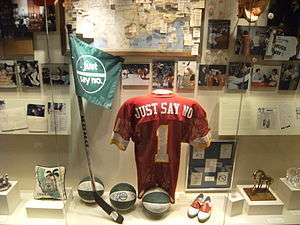
In the broadest definition of sports—physical recreation of all sorts—the four most popular sports among the general population of the United States are exercise walking (90 million), exercising with equipment (53 million), swimming (52 million) and camping (47 million). The most popular competitive sport (and fifth most popular recreational sport) is bowling (43 million). Other most popular sports are fishing (35 million), bicycling (37 million), weightlifting (33 million), aerobics (30 million), and hiking (28 million).[15]
According to a January 2018 Poll by Gallup, 37% of Americans consider football their favorite spectator sport, while 11% prefer basketball, 9% baseball, and 7% soccer. There is some variation by viewer demographics. Men, show a stronger preference for football than women, conservatives a stronger preference than liberals, and those over 35 a stronger preference than those under 35. In all groups, however, football is still the most popular. Basketball and soccer are more popular among liberals than conservatives.[86]
Baseball vs. football
_Vice_President_Johnson..._-_NARA_-_194197.jpg)
Though baseball has historically been called the "national pastime", American football has considerably grown in popularity with the advent of television over the last several decades. Most debates about "America's most popular sport" tend to center on the degree of Americans' identification with either of these two games; the question is a difficult one to resolve.[87]
.jpg)
Advocates of baseball point to the overwhelming number of baseball tickets sold annually in the United States and Canada, compared to NFL football. It is likely that the average American sports fan will attend many more major league baseball games than NFL football games in his or her lifetime, due in part to baseball's longer schedule and football's (generally) higher ticket prices.
Advocates of football, in turn, point to football's large television audience, including the Super Bowl, though the sport is also facing some negative publicity in the world of youth sports due to media coverage of documented health and injury risks posed to players, including the potential long-term health concerns that concussions pose for children or teenagers.[88][89] Certain teams of both sports, such as the Green Bay Packers, Boston Red Sox, New York Yankees, St. Louis Cardinals,[90] New England Patriots, Washington Redskins, Oakland Raiders and Pittsburgh Steelers,[91] have cultivated famously loyal fan bases across the country.
In many cases, identification with a certain football or baseball team is a matter of local identity and family inheritance going back many generations. Furthermore, the popularity of each, as well as of other major team sports, may vary depending on region, ethnicity and age.
Sports leagues in the United States
The five major sports leagues
The following table shows the major professional sports leagues, which average over 15,000 fans per game and that have a national TV contract that pays rights fees.
| League | Sport | Teams | National TV contract | Average Attendance | Total Annual Attendance | Ref |
|---|---|---|---|---|---|---|
| Major League Baseball (MLB) | Baseball | 30 | Fox, FS1, ESPN, TBS, MLBN | 30,023 | 72,670,423 | [92] |
| National Basketball Association (NBA) | Basketball | 30 | ABC, ESPN, TNT, NBATV | 17,884 | 21,997,875 | [93] |
| National Hockey League (NHL) | Ice hockey | 31 | NBC, NBCSN, NHLN | 17,500 | 21,525,777 | [94] |
| National Football League (NFL) | American football | 32 | CBS, Fox, NBC, ESPN, NFLN | 67,405 | 17,255,759 | [95] |
| Major League Soccer (MLS) | Soccer | 22 | Fox, FS1, ESPN, Univision | 22,106 | 8,267,534 | [96] |
Other team sports leagues
- American Ultimate Disc League (AUDL)
- Arena Football League (AFL)
- Association of Volleyball Professionals (AVP)
- Major Arena Soccer League (MASL)
- Major League Lacrosse (MLL)
- Major League Rugby (MLR)
- National Collegiate Athletic Association (NCAA)
- National Gay Flag Football League (NGFFL)
- National Lacrosse League (NLL)
- National Pro Fastpitch
- National Women's Soccer League (NWSL)
- North American Soccer League (NASL)
- Professional Inline Hockey Association (PIHA)
- United Soccer League (USL)
- United States Australian Football League (USAFL)
- USA Rugby League (USARL)
- Women's National Basketball Association (WNBA)
Other individual sports leagues
- Bellator Fighting Championships
- IndyCar (was Indy Racing League (IRL), merged with Champ Car)
- International Motor Sports Association (IMSA, sanctions IMSA SportsCar Championship)
- Legends Tour, for women's golfers 45 and over
- LPGA Tour
- National Association of Stock Car Automobile Racing (NASCAR)
- National Hot Rod Association (NHRA)
- PBA Tour
- Professional Bull Riders (PBR)
- Professional Rodeo Cowboys Association
- PGA Tour
- PGA Tour Champions, for men's golfers 50 and over; operated by the PGA Tour
- Professional Disc Golf Association (PDGA)
- Ultimate Fighting Championship (UFC)
- United States Bowling Congress (USBC)
- World Juggling Federation (WJF)
Sports governing bodies
- United States of America Cricket Association (USACA)
- USA Boxing (USAB)
- USA Basketball (USAB)
- USA Cycling (USAC)
- USA Hockey
- USA Table Tennis (USATT)
- USA Team Handball
- USA Track & Field (USATF)
- USA Volleyball
- United States Aquatic Sports (USAS)
- United States Bobsled and Skeleton Federation (USBFS)
- United States Golf Association (USGA)
- United States Snooker Association (USSA)
- United States Soccer Federation (USSF)
- United States Tennis Association (USTA)
See also
Footnotes
- ↑ The U.S. is guaranteed four places in the CONCACAF Champions League. Three places are automatically reserved for MLS teams: the MLS Cup winner (league champion), the Supporters' Shield winner (best regular-season record), and the team with the best regular-season record in the opposite conference from the Shield winner. The fourth place goes to the U.S. Open Cup winner, which is not necessarily an MLS team. Note that Canada-based MLS teams are not eligible to fill Champions League places reserved for MLS; those teams compete in the Canadian Championship, the winner of which receives that country's sole Champions League place. If a team qualifies for the Champions League by more than one method, or if a Canada-based team fills an automatic qualifying spot, the Champions League place passes to the U.S.-based MLS team with the best regular-season record among those not already qualified.
References
- ↑ Global sports market to hit $141 billion in 2012. Reuters. Retrieved on July 24, 2013.
- ↑ Jim, Normal. "Football Still Americans' Favorite Sport to Watch". news.gallup.com. Gallup. Retrieved 13 March 2018.
- ↑ Liss, Howard. Lacrosse (Funk & Wagnalls, 1970) pg 13.
- ↑ Quoted in Nancy L. Struna, "The Formalizing of Sport and the Formation of an Elite: The Chesapeake Gentry, 1650-1720s." Journal of Sport History 13#3 (1986) p 219. online
- ↑ "Archived copy". Archived from the original on May 17, 2008. Retrieved July 22, 2008.
- ↑ Oreovicz, John (January 6, 2008). "American open-wheel racing held hostage: Year 13". ESPN.com. Retrieved January 6, 2008.
- ↑ "After 12 years of conflict, IRL and Champ Car merge". ESPN.com. Associated Press. February 22, 2008. Retrieved February 22, 2008.
- ↑ "FloJo: World's Fastest Woman". CNN.
- ↑ "World's fastest woman Carmelita Jeter seeks Olympic gold". USA Today. June 22, 2011.
- ↑ Florence Griffith Joyner: Fastest Woman on Earth. Legacy.com. December 21, 2010.
- 1 2 3 4 Jonathan Beverly (October 6, 2008). "Runner's World: Born at the Right Time". Retrieved December 21, 2015.
- ↑ "The Rise of the Female Distance Runner «". Grantland.com. Retrieved September 25, 2016.
- ↑ "Why Boxing Is Becoming Less Relevent [sic] In America". Bleacher Report. Retrieved September 23, 2016.
- ↑ Flinn, Jenny. "The rise and rise of ultimate fighting (and why boxing is now so passé)". Theconversation.com. Retrieved September 23, 2016.
- 1 2 "Wayback Machine" (PDF). Web.archive.org. March 27, 2010. Archived from the original on March 27, 2010. Retrieved October 4, 2017.
- ↑ "Poll: Soccer nearly cracks America's top three favorite spectator sports", Philly Voice January 9, 2018. (citing a December 2017 Gallup poll)
- 1 2 "Wayback Machine" (PDF). Web.archive.org. October 21, 2011. Archived from the original on October 21, 2011. Retrieved October 4, 2017.
- ↑ Brown, Maury (February 8, 2016). "Super Bowl 50 Posts Near-Record TV Ratings With 111.9 Million Viewers". Forbes. Retrieved February 11, 2016.
- ↑ Frank Pallotta. "NBA Finals game 7 audience tops 30 million, biggest in 18 years". CNN Money. Retrieved June 25, 2016.
- ↑ "World Series TV ratings: Epic Game 7 was off the charts". USA Today. Retrieved November 24, 2016.
- ↑ "2014 World Cup final sets some U.S. TV records, but not all". Philly.com. Retrieved March 28, 2015.
- ↑ "Olympic final most-watched hockey game in 30 years". NHL.com. Retrieved August 13, 2015.
- ↑ The only states that sponsor neither baseball nor softball are South Dakota and Wyoming. No states in the Southern United States sponsor ice hockey.
- ↑ "Wayback Machine" (PDF). Web.archive.org. March 27, 2010. Archived from the original (PDF) on March 27, 2010. Retrieved October 4, 2017.
- 1 2 "Wayback Machine" (PDF). Web.archive.org. March 27, 2010. Archived from the original (PDF) on March 27, 2010. Retrieved October 4, 2017.
- ↑ The Great Plains States of America: People, Politics, and Power in the Nine ... – Neal R. Peirce – Google Books. Books.google.com. Retrieved March 28, 2015.
- ↑ Arbesman, Samuel; Strogatz, Steven (March 30, 2008). "A Journey to Baseball's Alternate Universe". The New York Times.
- ↑ "The Harris Poll". Harrisinteractive.com. Retrieved September 25, 2016.
- ↑ "largest Indiana high school gymnasiums". Indianahsbasketball.homestead.com. Retrieved September 4, 2012.
- ↑ "Is Steph Curry The Best Shooter Ever? Yes, Say Many of NBA's All-Time Marksmen". Bleacherreport.com. June 1, 2015. Retrieved June 1, 2015.
- ↑ Simmons, Bill (June 13, 2012). "Thunder Family Values". Grantland.com. Retrieved July 13, 2012.
- 1 2 Dryden, Ken (February 20, 2014). "Miracle Off Ice". Grantland.com. Retrieved February 20, 2014.
- ↑
- ↑ "Ultimate Frisbee On The Rise", CNBC, April 9, 2009.
- ↑ "IRB Development Global Map" Archived July 7, 2014, at the Wayback Machine., IRB.com. Retrieved June 15, 2014.
- ↑ "Archived copy". Archived from the original on June 18, 2013. Retrieved March 26, 2013.
- ↑ "Attendance Records" (PDF). Fs.ncaa.org. Retrieved September 25, 2016.
- ↑ "Top Moments: Vancouver's Attendance Record", Major League Ultimate, December 28, 2013.
- ↑ United States v. New Zealand, Soldier Field, Chicago.;
- ↑ "NCAA Men's Lacrosse Championship Finals Records 1971–2011" (PDF). Fs.ncaa.org. Retrieved September 25, 2016.
- ↑ "NCAA Statistics". Stats.ncaa.org. Retrieved September 25, 2016.
- ↑ "2011–12 Participation Study – Women's Sports" (PDF). NCAA Sports Sponsorship and Participation Rates Report, 1981–82 – 2011–12. NCAA. October 2012. p. 71. Retrieved January 4, 2013.
- ↑ "2011–12 Participation Study – Men's Sports" (PDF). NCAA Sports Sponsorship and Participation Rates Report, 1981–82 – 2011–12. NCAA. October 2012. p. 72. Retrieved January 4, 2013.
- 1 2 "Pro League Looks to Kick-Start American Rugby", The New York Times, Emma Stoney, April 25, 2016.
- ↑ "Archived copy" (PDF). Archived from the original (PDF) on June 26, 2011. Retrieved September 25, 2011.
- ↑ "Archived copy". Archived from the original on March 21, 2012. Retrieved January 14, 2012.
- 1 2 Worrall, Simon (October 2006). "Cricket, Anyone?". Smithsonian. Retrieved July 18, 2009.
- ↑ "American cricket gets ready for take-off". BBC News. Retrieved October 15, 2017.
- 1 2 3 Chetwynd, Josh. "Cricket, anyone? Obvious similarities make baseball, cricket sibling sports". Retrieved July 22, 2009.
- ↑ "International Cricket Council – The ICC – About The Organisation – History". Archived from the original on July 6, 2009. Retrieved July 22, 2009.
- ↑ Della Penna, Peter. "Have Kit, Will Play". Cricinfo. Retrieved April 28, 2011.
- ↑ Pengelly, Martin (April 13, 2014). "Why America will learn to love cricket". theguardian.com. Retrieved April 13, 2014.
- ↑ "Ultimate Frisbee Participation [SFIA]". Sludge Output. Retrieved October 17, 2014.
- ↑ Jordan Holtzman-Conston (2010). Countercultural Sports in America: The History and Meaning of Ultimate Frisbee. Waltham, Mass. ISBN 3838311957.
- ↑ "History of Frisbee and Flying Disc freestyle". Freestyle Players Association. Retrieved August 6, 2017.
- ↑ "World Flying Disc Federation". WFDF Official Website. Retrieved October 19, 2013.
- ↑ "World Flying Disc Federation". History of the Flying Disc. Archived from the original on October 19, 2013. Retrieved October 20, 2013.
- ↑ "Ken Westerfield's Pioneering Contributions To Frisbee Sports". Retrieved May 23, 2015.
- ↑ "History of Ultimate Frisbee and Disc Sports". Retrieved December 25, 2017.
- ↑ "Professional Disc Golf Association". PDGA Official Website. Retrieved October 19, 2013.
- ↑ "American Ultimate Disc League". AUDL Official Website. Retrieved October 20, 2013.
- ↑ "Ultimate Frisebee Recognized by the International Olympic Committee". World Flying Disc Federation. Retrieved August 4, 2015.
- ↑ "Ultimate Frisbee recognized by International Olympic Committee". Sports Illustrated Dan Gartland. Retrieved August 4, 2015.
- ↑ "MAAFL History". Mid American Australian Football League. 2005. Archived from the original on July 14, 2011. Retrieved September 30, 2012.
- ↑ "Bandy destined for the Olympic Winter Games!". Worldbandy.com. Retrieved October 4, 2017.
- ↑ Donahe, Tom (August 11, 2014). "Cricket is again making a hit in the U.S.; Olean teams part of resurgence in game's popularity". Olean Times Herald. Retrieved August 11, 2014.
- ↑ "The oldest international contest of them all". Cricinfo. Retrieved March 28, 2015.
- ↑ "US Tomahawks surprise packets of the rugby league World Cup". Usarl.com. Retrieved September 23, 2016.
- ↑ "Rugby League World Cup: Australia 62–0 USA". Bbc.com. November 16, 2013. Retrieved September 23, 2016 – via www.bbc.com.
- ↑ "USA and Canada to host 2025 Rugby League World Cup". Guardian. November 20, 2016. Retrieved November 25, 2016.
- ↑ Vickey, Ted (2008). 101 Fitness Games for Kids at Camp. Coaches Choice Books. p. 73. ISBN 978-1-58518-070-7.
- ↑ "Roller Derby Worldwide :: Find a Roller Derby League". Derbyroster.com. Retrieved March 28, 2015.
- ↑ The NCAA defines a participant as someone who "as of the day of the varsity team's first scheduled contest: (a) is listed as a team member; (b) practices with the varsity team and receives coaching from one or more varsity coaches; or (c)received athletically-related student aid."
- ↑ The NCAA does not give a number for total track and field, but breaks the figures into outdoor and indoor. The number given is for outdoor track and field. The total is likely to be somewhat higher.
- ↑ NFHS.org
- 1 2 "2016–17 High School Athletics Participation Survey" (PDF). National Federation of State High School Associations. Retrieved February 16, 2018.
- ↑ John Catsis, 'Sports Broadcasting (1996)
- ↑ Chris Gratton, and Harry Arne Solberg, The economics of sports broadcasting (Routledge, 2007)
- 1 2 Catsis, 'Sports Broadcasting (1996)
- ↑ Harry Arne Solberg and Knut Helland, "Sports broadcasting." Nordicom Review 32.2 (2011): 17–33.
- ↑ Matthew D. Shank and Mark R. Lyberger, Sports marketing: A strategic perspective (Routledge, 2014).
- ↑ "NBA to announce $24 billion TV deal". Retrieved January 12, 2018.
- ↑ "Report: Big Ten getting $2.64 billion in new TV deal". Retrieved January 12, 2018.
- ↑ "NHL, NBC sign record-setting 10-year TV deal". NHL.com. Retrieved January 12, 2018.
- ↑ "MLS, U.S. Soccer officially announce new TV deal with ESPN, Fox, Univision". Retrieved January 12, 2018.
- ↑ Inc., Gallup,. "Football Still Americans' Favorite Sport to Watch". Gallup.com. Retrieved 2018-06-05.
- ↑ "America's Favorite Pastime Baseball or Football [Archive] – WrestleZone Forums". Forums.wrestlezone.com. Retrieved September 25, 2016.
- ↑ "N.F.L. Acknowledges Long-Term Concussion Effects". The New York Times. Retrieved September 25, 2016.
- ↑ Zirin, Dave (March 18, 2010). "The NFL's Concussion Conundrum". Huffington Post.
- ↑ Joe Fitzhenry (June 12, 2012). "MLB Power Rankings: The Best and Worst Fanbases in Baseball". Bleacher Report. Retrieved September 25, 2016.
- ↑ "NFL's best fans? We gotta hand it to Steelers (barely) – NFL – ESPN". Sports.espn.go.com. August 29, 2008. Retrieved September 4, 2012.
- ↑ "MLB Attendance Report - 2017". ESPN. Retrieved August 7, 2018.
- ↑ "NBA Attendance Report - 2017". ESPN. Retrieved August 7, 2018.
- ↑ "nhl Attendance Report - 2017". ESPN. Retrieved August 7, 2018.
- ↑ "nfl Attendance Report - 2017". ESPN. Retrieved August 7, 2018.
- ↑ "2017 MLS Attendance". Soccer Stadium Digest. Retrieved August 7, 2018.
Further reading
- Gerdy, John R. Sports: The All-American Addiction (2002) online
- Gorn, Elliott J. A Brief History of American Sports (2004)
- Jackson III, Harvey H. ed. The New Encyclopedia of Southern Culture: Sports & Recreation (2011) online
- Jay, Kathryn. More Than Just a Game: Sports in American Life since 1945 (2004). online
- Sporting Events in Virginia

